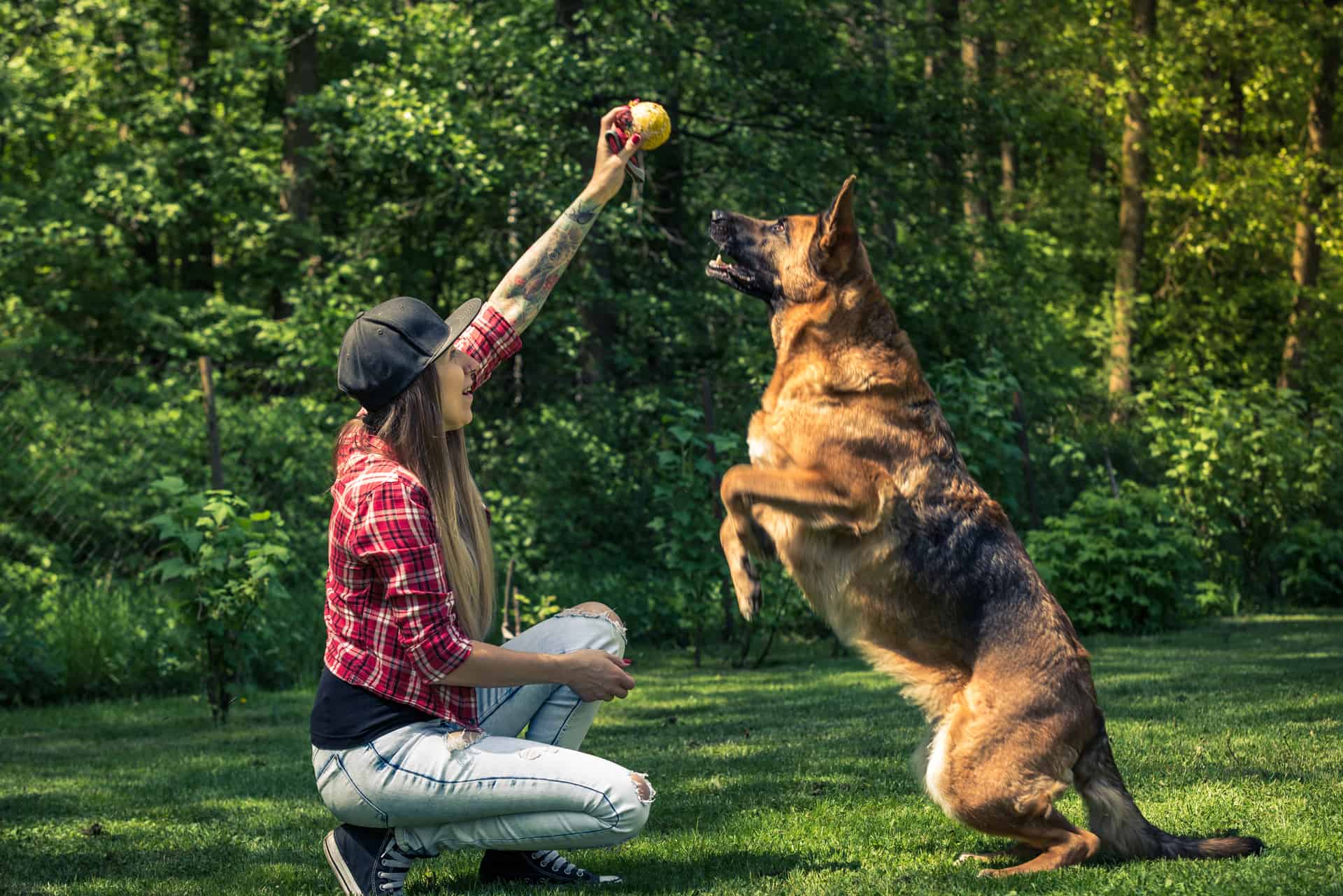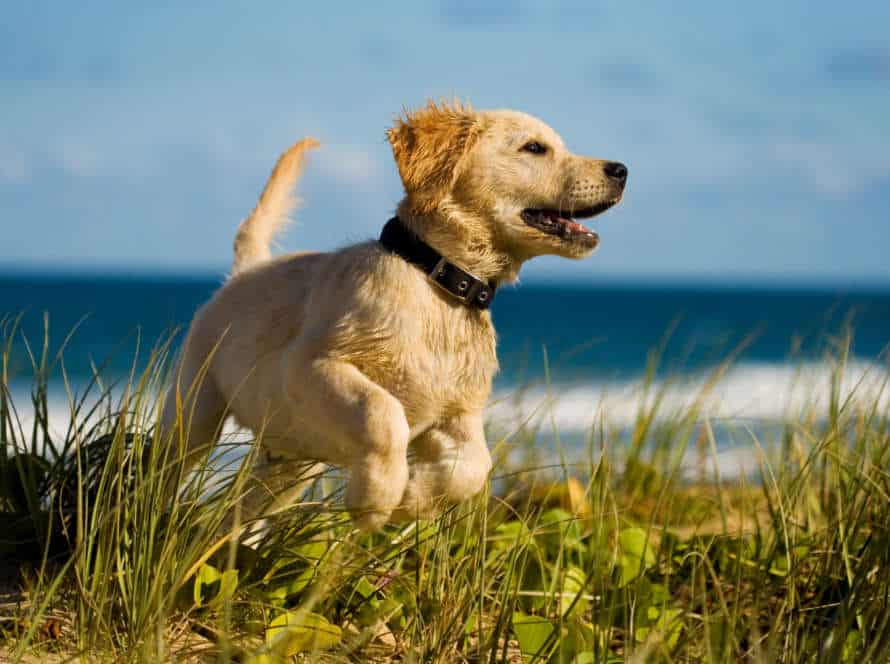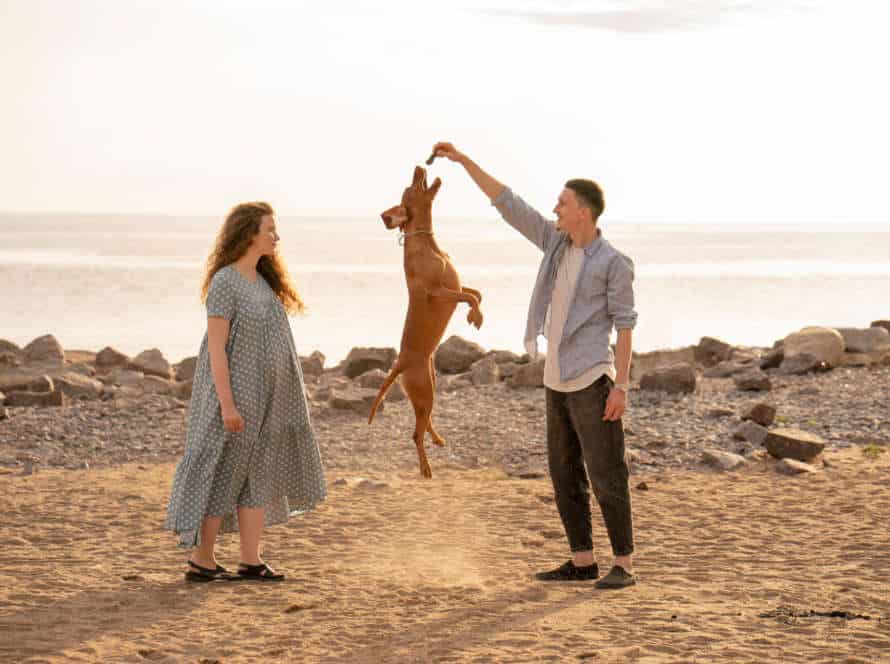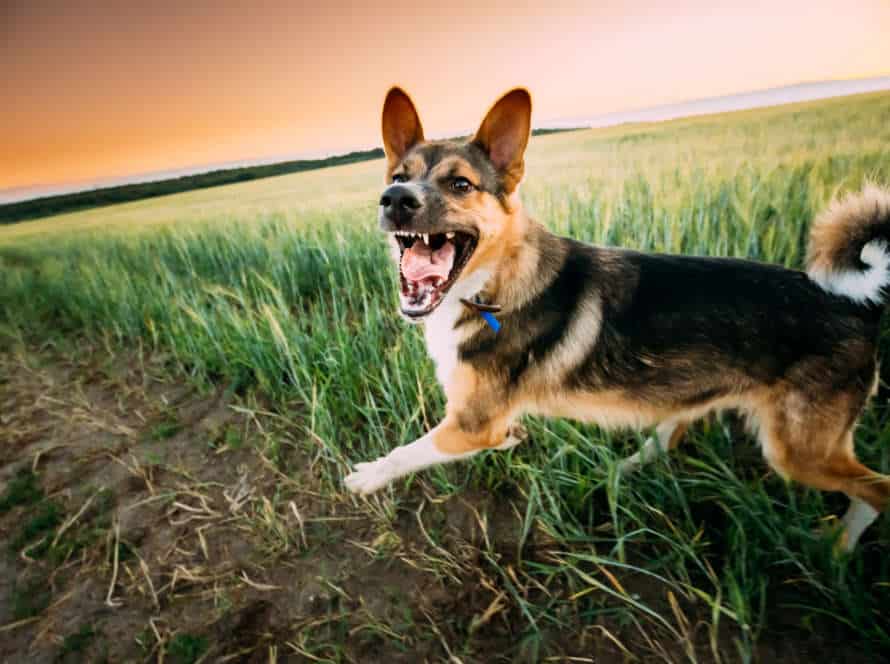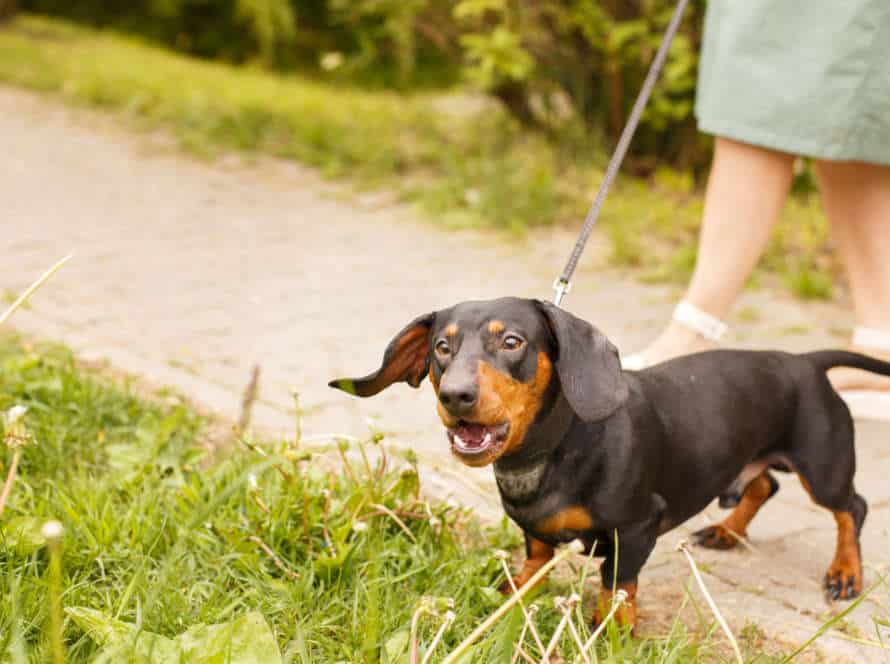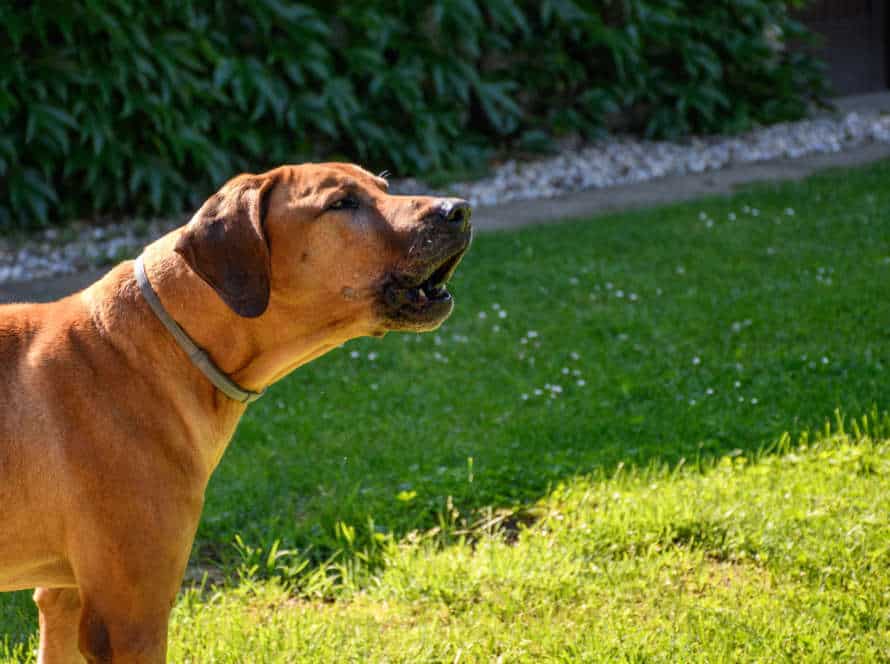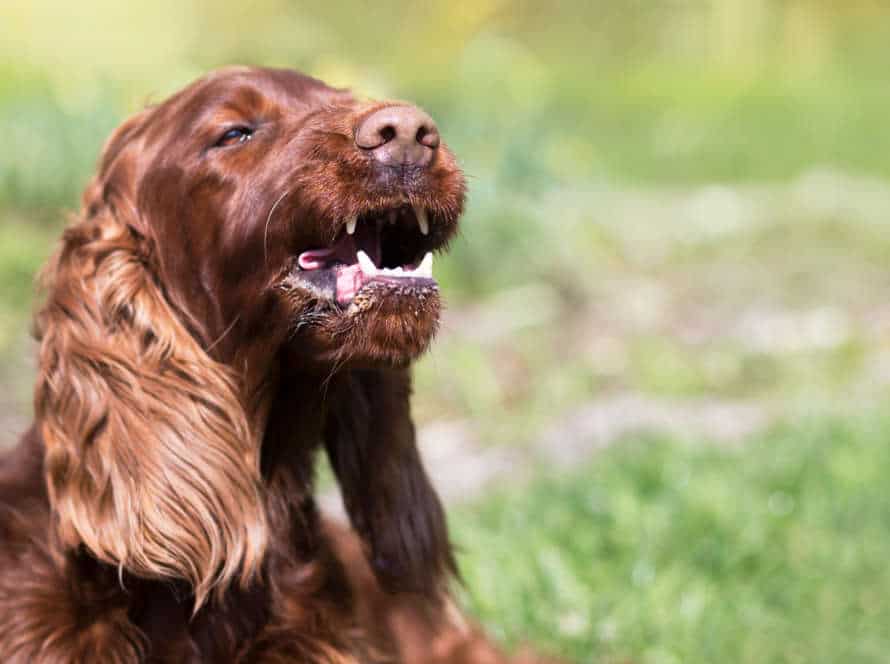Teaching Your Dog Tricks as an Alternative to Jumping
Got a pup that loves to jump? Tricks can be a fun way to help them learn to control that behavior. Follow these steps:
- Pick tricks your pup enjoys and are easy to learn, like ‘sit’, ‘stay’, ‘speak’ or ‘roll over’.
- Use positive reinforcement to train your pup to do these tricks.
- Replace jumping with tricks when guests come over. Teach your pup to ‘sit’ or show off a trick instead.
- Give treats and praise when they do the tricks correctly.
- Consistently practice and reinforce the tricks, to keep them interested and reduce their urge to jump.
Understanding Dog Behavior
Dogs possess an instinct to jump up when greeting or when they are elated. If a pup jumps up to greet people, then it may be interpreted as a display of aggression or a sign of inadequate socialization. To help dogs tackle this behavior, it is essential to comprehend why the dog is jumping in the first place. Grasping the dog’s behavior and motivations can assist you in teaching your pup other behaviors.
Why dogs jump
Jumping is a natural instinct for dogs. It may be a sign of excitement, playfulness, or anxiety. To teach them an alternative behaviour, it’s important to understand why they jump.
When dogs jump to greet humans or other pets, it may be to establish dominance, seek attention or start play. Watch their body language and tone of voice to work out the cause.
You can teach your dog different behaviours like “sit” or “shake hands” to stop jumping. Positive reinforcement like treats, toys, and verbal praise will help reinforce good behaviour.
Set boundaries with your dog and make sure they know what is allowed and what isn’t. Consistent training and behaviour management are key to helping them overcome bad habits such as jumping.
Pro tip: Dogs learn best when they have a routine. Quick training sessions during the day will help reinforce good behaviour and stop jumping.
Alternatives to jumping
Dogs naturally love to jump, but it can be annoying or even dangerous. An excellent alternative is teaching your pup tricks! Here are some to try:
- Sit – this is one of the most helpful and basic tricks.
- Roll Over – get your dog to lie down, then roll onto their back.
- Shake Hands – they lift one paw and place it into your hand.
- Play Dead – they lie down, then roll onto their side as if they are ‘playing dead’.
These tricks can help redirect your dog’s behavior. Use positive reinforcement and be patient with their learning process.
Reinforcing good behavior and discouraging bad behavior
It’s important to reinforce good behaviour and discourage bad behaviour when training your pup. Trick training is a great way to do this.
Pick an easy trick to teach your pup, like ‘shake’ or ‘spin’.
Use positive reinforcement, like treats and praise, to reward them for performing the trick correctly.
When your pup starts jumping, give the command for the trick and reward them with treats and praise when they do it.
Discourage jumping in a gentle way.
This technique redirects your pup’s energy to good behaviour and gives them an alternative to jumping.
Basic Commands to Teach Your Dog
Train your pup with simple commands like ‘Sit‘, ‘Stay‘ and ‘Come‘. This can be an effective way to stop jumping. It’s also great for mental health! Problem-solving, less boredom, and a stronger bond with you – all benefits of commands. Let’s take a look at some basic commands to teach your dog.
Sit
Teach your pup the “sit” command! It’s the most basic thing to do and has lots of advantages. It’ll help control their behavior, show you are the leader, and create a strong bond between you and your pet. Here’s how:
- Pick a quiet spot and use treats as a reward.
- Hold a treat up to their nose. Then, gently raise it above their head.
- As their head follows the treat, their bottom will naturally lower.
- When their bottom touches the ground, say “sit” and give them the treat.
- Keep repeating until your pup sits without the treat.
Another great way to redirect their enthusiasm is to teach them tricks.
Pro Tip: Begin training your pup while they are young. Puppies learn quickly and you won’t have to worry about bad habits. Also, don’t use force or aggression when training. It can harm your pup’s mental and emotional health.
Stay
Teaching your pup to do tricks is a great way to use up their energy and stop them from jumping, which can be damaging for them and those around them. You can teach them the following commands:
- “Sit” – This command can help your dog to sit on request and do tricks like “beg.”
- “Stay” – This command can make your pup stay in one spot while you work on a trick or do tricks like “roll over.”
- “Come” – You can use this command to get your dog back to you after a trick or to begin a new trick.
By giving your pup tricks, you can give them rewards and praise when they do well. Tip: Use treats and rewards to get your pet to learn new tricks and commands.
Lie down
It’s unusual, but training your pup to lie down can replace jumping and other bad habits. Here’s how:
- Hold a treat near your dog’s nose.
- Move it downwards.
- Your pup’s nose should hit the ground.
- Say “lie down” and give them the treat.
- Do this multiple times.
- Then, phase out the treat, so they rely on the verbal command.
- Once they master this, you can teach them more tricks like “play dead” or “roll over“.
These are fun and also help with unwanted behavior.
Pro tip: Be patient and consistent when teaching tricks.
Advanced Commands to Teach Your Dog
Want an alternative to jumping with your pup? Teach them tricks! This provides mental stimulation and encourages good behaviour. Commands like rolling over, playing dead and fetching can be taught. Here’s how to do it effectively!
Roll over
Train your pup to do “Roll Over!” It’s an amazing trick! Here’s how:
- Command your pup to “Down.”
- Kneel, holding a treat.
- Encourage pup to turn head towards the treat.
- Move treat in circle towards shoulder. This will make pup roll over to side.
- Command “Roll Over!” when pup starts to roll.
- Reward pup with treat and praise.
- Repeat the process, but use less treats each time. Eventually pup will know the trick and obey the command.
By teaching pup tricks, you can reduce jumping and direct energy into better behavior.
Play dead
Teach your pup an advanced trick! “Playing dead” is an awesome one. Start by teaching them to roll over on command. Before doing so, add a verbal cue like “Bang!” or “Play Dead!” On the command, they should roll over.
Gradually, you can stop using the roll-over part of the trick. Just use the verbal cue. Reward your pup with treats and praise when they do it correctly. With practice, they’ll be able to respond to the verbal cue alone.
Shake hands
Teach your pup a cool trick! Have ’em shake hands instead of jumping to say “hi.” Here’s how:
- Hold a treat in a closed fist.
- Offer it to your dog.
- Wait for ’em to paw your hand.
- Say “shake” and reward your pup with the treat.
- Open your fist, palm up.
- Say “shake” when they put their paw on your hand.
- Give a treat as a reward.
- With time, your dog will learn to do the trick when you say “shake.”
Tip: Use positive reinforcement and repetition. Offer lots of praise and rewards for good behaviour.
Using Positive Reinforcement to Train Your Dog
Train your pup tricks for a strong connection with them. Use positive reinforcement and rewards like treats, voice praises or petting. This reinforcement with a rewards system will help your dog to learn the trick faster.
Here’s how to use reinforcement to teach your furry pal tricks:
Choosing the right treats
Choosing the right treats is super important when using positive reinforcement to train your pup. Keep these things in mind:
- High Value: Pick treats that are valuable to your dog. Think cooked chicken or steak.
- Size: Treats should be small, so your pup can eat them quickly.
- Healthy: Select healthier snacks like fruit and veg to keep your pup’s weight in check.
- Variety: Mix it up! Use a combination of treats to avoid overfeeding and make it fun.
Once you’ve chosen the right treats, use them consistently. Positively reinforce the desired behavior – it’ll help your furry friend learn and grow.
Using verbal praise and physical affection
Positive reinforcement is an awesome way to get your pup to do tricks, like “sit” or “high five,” instead of jumping up on people.
How? Verbal praise & physical affection.
When your dog performs the trick, give them immediate verbal praise, like “good boy” or “good girl.” At the same time, give physical affection, like a belly rub or head pat.
As they get better, gradually replace the physical affection with verbal praise. Eventually, your pooch will understand that the trick equals positive reinforcement and will do it more often.
Training gradually over time
Training your pup gradually is key for positive reinforcement and teaching them new tricks, instead of jumping. Here’s the process:
- Begin with simple orders like “sit” or “stay” and reward them with a treat or praise.
- Step it up with more difficulty, like adding distractions or longer duration.
- Use positive reinforcement tactics, like clicker training or a high-pitched voice, to reward them for good behavior.
- Skip punishment or negative reinforcement, as this can make them anxious or confused.
- Teach them different behaviors to jumping, like “shake” or “roll over” and reward them for it.
Consistency and patience are vital. Pro tip: Use tasty treats, like cooked chicken or cheese, to keep them motivated and interested in learning.
Troubleshooting Common Problems
Training your doggy to do tricks or commands can be a great way to keep it healthy. Plus, it provides brain stimulation that can stop problems like too much jumping. However, getting your pup to learn the commands can prove tricky. In this section, we’ll look at common issues that happen when teaching tricks, and how to sort them out.
Expecting too much too soon
Pet owners often expect too much when teaching their pup tricks, other than jumping. Patience and consistency are key when training. Here’s some help for common hiccups:
- Break the trick into smaller parts
- Encourage good behavior with treats or praise
- No scolding or punishing
- Keep sessions short
- Progress difficulty as your pup gets better
- And, remember, learning takes time – be patient and enjoy the little wins
Inconsistency in training
Trainin’ yer pup can be tough, espesh’lly if there’s inconsistency. This can happen when multiple trainers are involved, or when sessions are sporadic.
To avoid this, here’s whatcha gotta do:
- Choose one trainin’ method and stick to it.
- Set a consistent schedule and don’t let it waver.
- Use the same verbal and visual cues, like “sit” and a hand signal.
- And most importantly, be patient and keep yer consistency! It may take several weeks, or even months, ta get yer pup behavior just right.
Pro tip: Consistency is key in trainin’ yer pup. Stick to one method, set a schedule, and use the same verbal and visual cues. Above all, patience and consistency are the keys ta success!
Dealing with regression in behavior
Dealing with bad behaviour can be difficult. But teaching your pup new tricks is a great way to change their energy and stop jumping and other unwanted activities. Here’s why:
- Tricks can keep your pup mentally occupied, stopping them getting bored or restless.
- Training your pet to do new things can take their focus away from bad behaviour like jumping.
- Trick training can also help you bond with your pup, build trust and communication.
So the next time you spot regression in behaviour, try teaching them a new trick and see if it helps!
Conclusion: Enjoying Time with Your Dog while Teaching Them New Tricks
Training your pup is a great way to bond and direct their energy positively. Here are the steps to follow:
- Pick a trick, such as sit, shake, or roll over.
- Use positive reinforcement – reward them with a treat or praise when they do it right.
- Repeat regularly until they master the trick.
- Use the trick as an alternative to bad behavior.
- It’s a fun way to build a stronger bond and teach them proper behavior.
Pro Tip: Be consistent with commands and methods.
Frequently Asked Questions
Q: What are some tricks I can teach my dog to discourage jumping?
A: There are plenty of tricks you can teach your dog, including sit, stay, shake, roll over, and spin.
Q: How can teaching my dog tricks help discourage jumping?
A: When you teach your dog tricks, you are providing mental stimulation and exercise, which can reduce overall energy levels and curb unwanted behaviors like jumping.
Q: How can I get my dog interested in learning tricks?
A: Use positive reinforcement and treats to encourage your dog to perform desired behaviors. Make training sessions fun and engaging, and keep them short for best results.
Q: What if my dog still jumps even after learning tricks?
A: If your dog continues to jump, you may need to address underlying behavioral issues or seek professional training to help modify the behavior.
Q: Are there any tricks that can specifically discourage jumping?
A: Tricks like “off” (teaching your dog to get down or stay off of furniture) and “wait” (teaching your dog to pause and not jump until given permission) can be effective in discouraging jumping.
Q: How long does it take to teach a dog a new trick?
A: The length of time it takes to teach a new trick can vary depending on your dog’s ability and motivation level. Some dogs may pick up a new trick in a few training sessions, while others may take longer to master the behavior.

